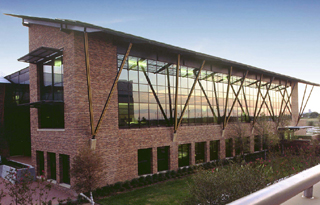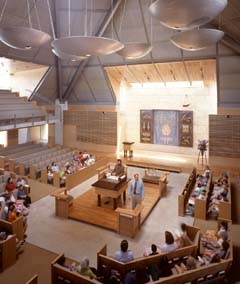|
Subscribe / Renew |
|
|
Contact Us |
|
| ► Subscribe to our Free Weekly Newsletter | |
| home | Welcome, sign in or click here to subscribe. | login |
Architecture & Engineering
| |
December 10, 2003
Design Detailings: USGS funds study of quake hazards
Seattle consulting geologist William C. Haneberg has been awarded a one-year contract to investigate how errors in computer data sets affect the reliability of maps showing the potential for earthquake-triggered landslides.
The project, funded by the National Earthquake Hazards Reduction Program through the U.S. Geological Survey, will use global positioning system receivers to find errors in digital elevation models of the earth's surface and evaluate their effects.
Once Haneberg has information about the sizes and locations of the errors, he will use a mathematical procedure known as geostatistical simulation to generate alternative versions of the earth's surface.
The results can be used to make more reliable maps of potential hazards in earthquake prone areas such as the Puget Sound region, the San Francisco Bay Area and southern California. His approach has attracted international interest from researchers.
The results may have applications in environmental science and engineering that are not related to earthquakes. Computer simulations of storm runoff, flood hazards, erosion and sedimentation, groundwater recharge, wetland occurrence and landslides triggered by rainfall can rely on digital elevation models containing the same kind of errors.
Haneberg is an authority on landslides and other geologic hazards, and is currently serving as the chairman of the Geological Society of America's Engineering Geology Division.
San Antonio firm wins AIA top award

Photo by David Lake
Lake/Flato Architects designed the Burlington Northern Santa Fe Railroad in Fort Worth. Lake/Flato won AIA's Firm Award.
|
The Board of Directors of the American Institute of Architects recently named the San Antonio firm Lake/Flato Architects recipient of the 2004 AIA Architecture Firm Award. The award last year went to Seattle's Miller|Hull Partnership.
Lake/Flato's work ranges from family retreats to museums, arboretums and corporate headquarters. Over the last 20 years, the firm has won more than 90 regional and national architecture awards, including AIA's Honor Award in 1992, 1997 and 1999.
The 44-member firm emphasizes individual creativity and teamwork, according to the AIA, and has helped revitalize downtown San Antonio.

Photo by Paul Hester
Lake/Flato's Congregation Agudas Achim in Austin.
|
The late architect William Turnbull wrote that Lake/Flato has "specifically Texas insights, but the quality of their translation into architecture can serve as a lesson for us all -- how a building stands to the sun, how it welcomes the cooling breeze. Nothing sensational or exotic, no visual fireworks of fashion, just architecture that intrigues the mind, delights the soul, and refreshes the eye with its elegant detail and simplicity."
The AIA Architecture Firm Award is the highest honor the AIA gives a firm, and recognizes a practice that has consistently produced distinguished architecture for at least 10 years.
UW artists adorn South Park district
University of Washington Students in the Public Art Program have been working since September to lend their skills to a business district revitalization effort in the South Park neighborhood. The project is being funded with federal money.
The 20 students in the public art class have developed concepts for metal street banners and public murals for the small South Park business district along 14th Avenue South. The artwork and banners reflect the past and present heritage of the community and are part of an overall project to revitalize the neighborhood business district.
Final design, fabrication and installation of the artwork will be through federal Community Development Block Grant funds. Once the designs have been approved by the neighborhood, installation should take place in the spring. The public mural will come later in the year.
WSU students pitchRookery Block plan
Students at Washington State University Spokane's Interdisciplinary Design Institute will present design concepts Friday for the historic Rookery Block in downtown Spokane. The presentation will be from 2:30 to 5 p.m. in the WSU Phase I Classroom Building Gallery.
The concepts are the product of a semester-long project. The designs will be reviewed by Greg Kessler, director of the WSU School of Architecture and Construction Management; Bob Power, owner of a building adjacent to the Rookery Block; city planner Steve Franks; and interested community members.
Students mapped the 24-square-block area surrounding Rookery Block, located on Riverside Avenue. The maps include first- and second-floor plans of all buildings, sections, elevations, human use patterns, historical development figure grounds, property use maps and semi-abstract color maps of details and materials.
CollinsWoerman builds 100 bikes
Employees of CollinsWoerman, a Bellevue architecture firm, last week participated in the 100 Bikes for 100 Kids benefit for the Forgotten Children's Fund.
This is the second year CollinsWoerman has teamed up with the Forgotten Children's Fund for the 100 Bikes for 100 Kids event. The company participated in the event, in lieu of having a Christmas party. CollinsWoerman also provided one large food basket and three wrapped gifts per child, including a coat for the kids and families who receive the bikes.
"We can't afford to let children go overlooked, especially during the holidays," said Mark Woerman, principal of CollinsWoerman. "Assembling and donating these bikes is our way of showing that we care about our local kids and want them to have a happy holiday season."


